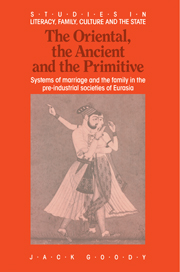 The Oriental, the Ancient and the Primitive
The Oriental, the Ancient and the Primitive Book contents
- Frontmatter
- Contents
- List of illustrations
- List of tables
- Preface
- 1 The nature of the enterprise
- PART I CHINA
- PART II INDIA
- 6 Marriage and the family in Gujarat
- 7 The high and the low
- 8 The North and the South
- 9 Kinship and modes of production
- PART III THE NEAR EAST
- PART IV GREECE AND ROME, YESTERDAY AND TODAY
- Notes
- References
- Index
6 - Marriage and the family in Gujarat
Published online by Cambridge University Press: 09 January 2010
- Frontmatter
- Contents
- List of illustrations
- List of tables
- Preface
- 1 The nature of the enterprise
- PART I CHINA
- PART II INDIA
- 6 Marriage and the family in Gujarat
- 7 The high and the low
- 8 The North and the South
- 9 Kinship and modes of production
- PART III THE NEAR EAST
- PART IV GREECE AND ROME, YESTERDAY AND TODAY
- Notes
- References
- Index
Summary
This chapter will concentrate upon marriage and the family in Gujarat, and is based upon short spells of fieldwork in India, discussions with the members of the Gujarati community in England and an examination of other studies of the region. A more general reason for starting in the North, apart from the natural sequence following from Tibet, is that in recent years a number of influential analyses of marriage and the family in India have been based on the South and these have tended, at least among anthropologists, to set the themes for the study of the whole of the sub-continent.
Here we begin from a different vantage point, geographically and comparatively. In relation to our general theme, the most relevant works on Gujarat are those of Shah (1956, 1974, 1982) and Pocock on the Kanbi or Patidars (1972 and 1973), the major farming caste of the region. In the introduction to the first of his two studies, Pocock apologises for the lack of information on economic pursuits, indeed on the economy in general. Since he was dealing with a caste of working landowners whose activities were based on their title to that scare resource, land (and the water to irrigate part of it), a resource that was unequally divided between members of the caste, economic factors are clearly of considerable importance. That is especially true where the local productive system is based largely on domestic groups and where marriage involves the differential commitment of resources in order to establish a union among equals or better.
- Type
- Chapter
- Information
- The Oriental, the Ancient and the PrimitiveSystems of Marriage and the Family in the Pre-Industrial Societies of Eurasia, pp. 160 - 178Publisher: Cambridge University PressPrint publication year: 1990


